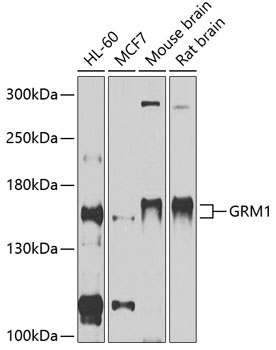Anti-GRM1 Antibody (CAB11462)
- SKU:
- CAB11462
- Product type:
- Antibody
- Reactivity:
- Human
- Mouse
- Rat
- Host Species:
- Rabbit
- Isotype:
- IgG
- Antibody Type:
- Polyclonal Antibody
- Research Area:
- Cell Biology
Description
| Antibody Name: | Anti-GRM1 Antibody |
| Antibody SKU: | CAB11462 |
| Antibody Size: | 20uL, 50uL, 100uL |
| Application: | WB |
| Reactivity: | Human, Mouse, Rat |
| Host Species: | Rabbit |
| Immunogen: | Recombinant fusion protein containing a sequence corresponding to amino acids 920-1140 of human GRM1 (NP_000829.2). |
| Application: | WB |
| Recommended Dilution: | WB 1:500 - 1:2000 |
| Reactivity: | Human, Mouse, Rat |
| Positive Samples: | HL-60, MCF7, Mouse brain, Rat brain |
| Immunogen: | Recombinant fusion protein containing a sequence corresponding to amino acids 920-1140 of human GRM1 (NP_000829.2). |
| Purification Method: | Affinity purification |
| Storage Buffer: | Store at -20°C. Avoid freeze / thaw cycles. Buffer: PBS with 0.02% sodium azide, 50% glycerol, pH7.3. |
| Isotype: | IgG |
| Sequence: | NETA CNQT AVIK PLTK SYQG SGKS LTFS DTST KTLY NVEE EEDA QPIR FSPP GSPS MVVH RRVP SAAT TPPL PSHL TAEE TPLF LAEP ALPK GLPP PLQQ QQQP PPQQ KSLM DQLQ GVVS NFST AIPD FHAV LAGP GGPG NGLR SLYP PPPP PQHL QMLP LQLS TFGE ELVS PPAD DDDD SERF KLLQ EYVY EHER EGNT EEDE LEEE EEDL QAAS KLTP D |
| Gene ID: | 2911 |
| Uniprot: | Q13255 |
| Cellular Location: | Cell membrane, Multi-pass membrane protein |
| Calculated MW: | 101kDa/132kDa |
| Observed MW: | 132kDa |
| Synonyms: | GRM1, GPRC1A, MGLU1, MGLUR1, PPP1R85, SCAR13 |
| Background: | This gene encodes a metabotropic glutamate receptor that functions by activating phospholipase C. L-glutamate is the major excitatory neurotransmitter in the central nervous system and activates both ionotropic and metabotropic glutamate receptors. Glutamatergic neurotransmission is involved in most aspects of normal brain function and can be perturbed in many neuropathologic conditions. The canonical alpha isoform of the encoded protein is a disulfide-linked homodimer whose activity is mediated by a G-protein-coupled phosphatidylinositol-calcium second messenger system. This gene may be associated with many disease states, including schizophrenia, bipolar disorder, depression, and breast cancer. Alternative splicing results in multiple transcript variants encoding different isoforms. |
| UniProt Protein Function: | mGluR1: Receptor for glutamate. The activity of this receptor is mediated by a G-protein that activates a phosphatidylinositol- calcium second messenger system. May participate in the central action of glutamate in the CNS, such as long-term potentiation in the hippocampus and long-term depression in the cerebellum. Homodimer; disulfide-linked. The PPXXF motif binds HOMER1, HOMER2 and HOMER3. Interacts with SIAH1, RYR1, RYR2, ITPR1, SHANK1, SHANK3 and GRASP. Belongs to the G-protein coupled receptor 3 family. 2 isoforms of the human protein are produced by alternative splicing. |
| UniProt Protein Details: | Protein type:GPCR, family 3; Membrane protein, integral; Membrane protein, multi-pass; Receptor, GPCR Chromosomal Location of Human Ortholog: 6q24.3 Cellular Component: integral to plasma membrane; plasma membrane; postsynaptic density; presynaptic membrane Molecular Function:G-protein coupled receptor activity; glutamate receptor activity; protein binding Biological Process: elevation of cytosolic calcium ion concentration during G-protein signaling, coupled to IP3 second messenger (phospholipase C activating); G-protein coupled receptor protein signaling pathway; metabotropic glutamate receptor signaling pathway; metabotropic glutamate receptor, adenylate cyclase inhibiting pathway; regulation of synaptic transmission, glutamatergic; synaptic transmission Disease: Spinocerebellar Ataxia, Autosomal Recessive 13 |
| NCBI Summary: | This gene encodes a metabotropic glutamate receptor that functions by activating phospholipase C. L-glutamate is the major excitatory neurotransmitter in the central nervous system and activates both ionotropic and metabotropic glutamate receptors. Glutamatergic neurotransmission is involved in most aspects of normal brain function and can be perturbed in many neuropathologic conditions. The canonical alpha isoform of the encoded protein is a disulfide-linked homodimer whose activity is mediated by a G-protein-coupled phosphatidylinositol-calcium second messenger system. This gene may be associated with many disease states, including schizophrenia, bipolar disorder, depression, and breast cancer. Alternative splicing results in multiple transcript variants encoding different isoforms. [provided by RefSeq, May 2013] |
| UniProt Code: | Q13255 |
| NCBI GenInfo Identifier: | 311033443 |
| NCBI Gene ID: | 2911 |
| NCBI Accession: | Q13255.3 |
| UniProt Secondary Accession: | Q13255,Q13256, Q14757, Q14758, Q5VTF7, Q5VTF8, Q9NU10 Q9UGS9, Q9UGT0, B9EG79, F8W805, |
| UniProt Related Accession: | Q13255 |
| Molecular Weight: | |
| NCBI Full Name: | Metabotropic glutamate receptor 1 |
| NCBI Synonym Full Names: | glutamate metabotropic receptor 1 |
| NCBI Official Symbol: | GRM1 |
| NCBI Official Synonym Symbols: | MGLU1; GPRC1A; MGLUR1; SCAR13; PPP1R85 |
| NCBI Protein Information: | metabotropic glutamate receptor 1 |
| UniProt Protein Name: | Metabotropic glutamate receptor 1 |
| Protein Family: | Metabotropic glutamate receptor |
| UniProt Gene Name: | GRM1 |



